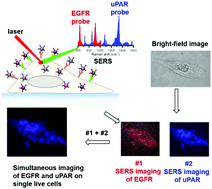Surface-enhanced Raman spectroscopy (SERS) nanoprobes for ratiometric detection of cancer cells†
Abstract
We report a ratiometric strategy for detection of different types of breast cancer cells by surface-enhanced Raman spectroscopy (SERS), which simultaneously quantifies the levels of dual biomarkers distinctly expressed on cancer cells to consequently achieve their expression ratio. Two SERS nanoprobes that are encoded with distinct SERS signatures are conjugated with urokinase plasminogen activation receptor (uPAR)- and epidermal growth factor receptor (EGFR)-targeting peptides. The SERS imaging of single live cells can accurately quantify the cellular biomarker expression difference from the SERS intensity ratio and is further employed for cancer cell screening. The results show that MDA-MB-231 and MCF-7 exhibit distinct expression of the uPAR and EGFR and they can be respectively discriminated by the intensity ratio of SERS signals from uPAR- and EGFR-targeting SERS nanoprobes. The ratiometric strategy permits background-free SERS detection of cancer cells and dramatically improves the signal-to-noise ratio of targeted cellular SERS imaging, thus enabling accurate cancer cell screening without the need for additional references. It is believed that the present ratiometric method should be a promising avenue for breast cancer diagnostics and screening, which can be easily extended for detection of other cancer cell types.



 Please wait while we load your content...
Please wait while we load your content...